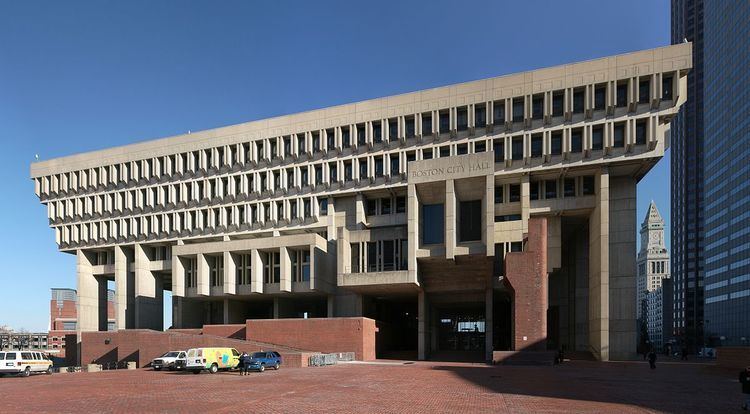 | ||
Campbell, Aldrich & Nulty was a Boston, Massachusetts, United States, architectural firm. The firm's principals were forefront modernists, during the 1950s-1970s period when International Modernism matured in America. The successors to Campbell & Aldrich, the principals at Campbell, Aldrich & Nulty were Nelson Wilmarth Aldrich, who in the late 1930s studied under Walter Gropius and Marcel Breuer at the Harvard Graduate School of Design, and Lawrence Frederick Nulty. In the late 1960s and in the 1970s, the partnership of Nelson Wilmarth Aldrich and Lawrence Frederick Nulty designed some of New England's most recognizable and controversial modernist architecture.
Contents
Building designs
Some of the New England structures designed by Campbell, Aldrich & Nulty in a modernist and frequently also brutalist architecture are Boston's 100 Federal Street 37-floor skyscraper, which was formerly known as the First National Bank Building and is nicknamed the Pregnant Building; the Lederle Graduate Research Center at the University of Massachusetts, Amherst; the Merrill Science Center at Amherst College; the Weiss Science Tower at Rockefeller University; the Murdough Center at New Hampshire's Dartmouth College; and Boston City Hall. A 1976 poll of architects, historians and critics conducted by the American Institute of Architects listed the Boston City Hall with Thomas Jefferson's University of Virginia campus and Frank Lloyd Wright's Fallingwater as one of the ten proudest achievements of American architecture in the nation's first two hundred years.
Restorations
Campbell, Aldrich & Nulty also completed renovations of some of Massachusetts' best known historical buildings, including modern annexes for some. Notable among these renovations and additions are those at Trinity Church (Boston), the only church in the United States and the only building in Boston considered by the American Institute of Architects to be one of the "Ten Most Significant Buildings in the United States"; Emmanuel Episcopal Church, Boston; and Salem, Massachusetts' John Tucker Daland House.
Nelson Wilmarth Aldrich
Campbell, Aldrich & Nulty's Nelson Wilmarth Aldrich (1911 – 1986) was not only an American modernist architect, but also a proponent of correlating theories of urbanism and urban planning. A nationally recognized social scientist, he was elected a fellow of the American Academy of Arts and Sciences in 1964. A Boston civic leader, in the 1960s Nelson Wilmarth Aldrich was appointed a distinguished member of that city's Urban Renewal Design Advisory Committee with note that he was a principal at Campbell, Aldrich & Nulty. He was a trustee of the Institute of Contemporary Art, Boston (1947-1960), the Boston Arts Festival (1955–62), the Metropolitan Boston Arts Center (1959-1963), the Rhode Island School of Design (1955-1962), Radcliffe College (1957-1972), and the Boston Architectural Center (1968-1973). Aldrich received his architecture degrees from Harvard University. Nelson Wilmarth Aldrich was the cousin of U.S. Vice President Nelson Aldrich Rockefeller and the nephew of Abby Aldrich (Rockefeller), the daughter of the U.S. Senator Nelson Wilmarth Aldrich (1841-1915) and wife of John D. Rockefeller, Jr.
